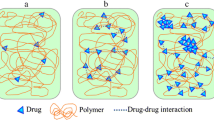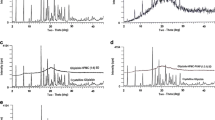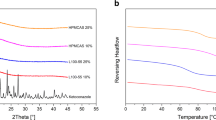Abstract
The induction period of crystallization of amorphous naproxen in solid dispersion was measured by DSC. Hydroxypropylmethylcellulose acetate succinate LG (HPMCAS-LG) was selected as a polymer of solid dispersion, because of the excellent inhibitory effect of crystallization. Naproxen was chosen as a model drug having poor water solubility and poor physical stability of glassy state. The prediction of crystallization of amorphous naproxen in solid dispersion at the desired storage temperature or the desired polymer content was carried out. If the storage condition satisfied the requirement that was either more than 90% of HPMCAS-LG content at 333 K or below storage temperature of 301 K for 50% HPMCAS-LG content, the induction period of crystallization of naproxen in solid dispersion would be more than 1 year. The storage period of amorphous drug in solid dispersion of desired storage temperature and desired drug content might be predictable from measurement data of induction period of crystallization.







Similar content being viewed by others
References
Leuner C, Dressman J. Improving drug solubility for oral delivery using solid dispersions. Eur J Pharm Biopharm. 2000;50:47–60.
Weuts I, Kempena D, Decorte A, Verreck G, Peeters J, Brewster M, et al. Physical stability of the amorphous state of loperamide and two fragment molecules in solid dispersions with the polymers PVP-K30 and PVP-VA64. Eur J Pharm Sci. 2005;25:313–20.
Kanaze FI, Kokkalou E, Niopas I, Georgarakis M, Stergiou A, Bikiaris D. Thermal analysis study of flavonoid solid dispersions having enhanced solubility. J Therm Anal Calorim. 2006;83:283–90.
Mashru RC, Sutariya VB, Sankalia MG, Yagnakumar P. Characterization of solid dispersions of rofecoxib using differential scanning calorimeter. J Therm Anal Calorim. 2005;82:167–70.
Bartsch SE, Griesser UJ. Physicochemical properties of the binary system glibenclamide and polyethylene glycol 4000. J Therm Anal Calorim. 2004;77:555–69.
Verheyen S, Blaton N, Kinget R, Van den Mooter G. Pharmaceutical performance of solid dispersions containing poly(ethylene glycol) 6000 and diazepam or temazepam. J Therm Anal Calorim. 2004;76:405–16.
Torricelli C, Martini A, Muggetti L, De Ponti R. Stability studies on a steroidal drug/b-cyclodextrin coground mixture. Int J Pharm. 1991;71:19–24.
Yoshihashi Y, Iijima H, Yonemochi E, Terada K. Estimation of physical stability of amorphous solid dispersion using differential scanning calorimetry. J Therm Anal Calorim. 2006;85:689–92.
Carolina PM, Fleming M. Solubility of naproxen in several organic solvents at different temperatures. Fluid Phase Equilib. 2007;255:70–7.
Fedors RF. A method for estimating both the solubility parameters and molar volumes of liquids. Polym Eng Sci. 1974;14:147–54.
Sakellariou P, Rowe RC, White EFT. The solubility parameters of some cellulose derivatives and polyethylene glycols used in tablet film coating. Int J Pharm. 1986;31:175–7.
Hiraoka H, Hildebrand JH. Solubility relations of the isomeric trichlorotrifluoroethanes. J Phys Chem. 1963;67:916–8.
Cui Y, Frank SG. Isothermal crystallization kinetics of lidocaine in supersaturated lidocaine/polyacrylate pressure sensitive adhesive systems. J Pharm Sci. 2005;94:2039–48.
Harano Y, Nakano K, Saito M, Imoto T. Nucleation rate of potassium chlorate from quiescent supersaturated aqueous solution. J Chem Eng Jpn. 1976;9:373–7.
Turnbull D, Fisher JC. Rate of nucleation in condensed systems. J Chem Phys. 1949;17:71–3.
Acknowledgements
This research was partially supported by Grant-in-Aid for Scientific Research (C) (18590242) from Japan Society for the Promotion of Science (JSPS), and the Science Research Promotion Fund from the Promotion and Mutual Aid Corporation for Private Schools of Japan.
Author information
Authors and Affiliations
Corresponding author
Rights and permissions
About this article
Cite this article
Yoshihashi, Y., Yonemochi, E., Maeda, Y. et al. Prediction of the induction period of crystallization of naproxen in solid dispersion using differential scanning calorimetry. J Therm Anal Calorim 99, 15–19 (2010). https://doi.org/10.1007/s10973-009-0480-y
Published:
Issue Date:
DOI: https://doi.org/10.1007/s10973-009-0480-y




